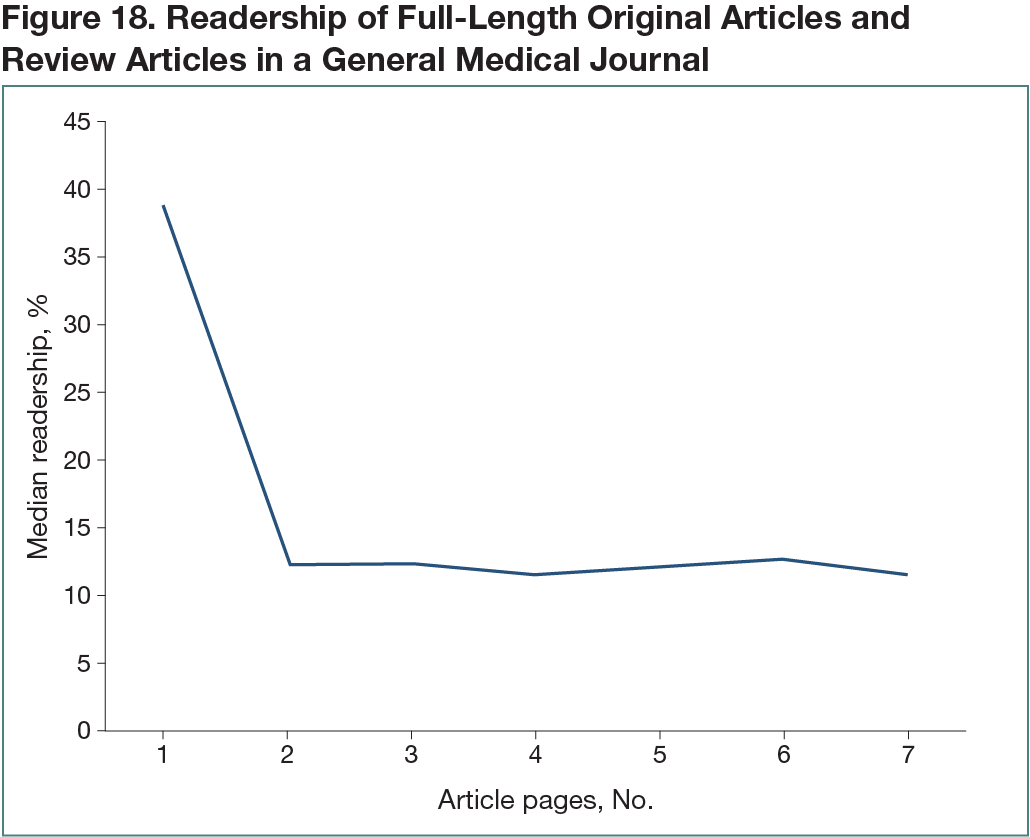Abstract
Primary Care Physician Readership Practices of the Printed Versions of Deutsches Ärzteblatt
Christopher Baethge,1,2 Jeremy Franklin3
Objective
How medical journal audiences read scientific articles is of key interest to authors and editors, but there are few publications on reading patterns. To better understand reading behavior, surveys of readers of a print general medical journal conducted with physicians in private practice were analyzed, with a focus on reading rates, popularity of different kinds of articles, attraction of tables or figures, and how readership declined with increasing numbers of pages in an article.
Design
This was a survey study of readers of Deutsches Ärzteblatt, the journal of the German Medical Association and the National Association of Statutory Health Insurance Physicians. During regular surveys between 2000 and 2019, changing groups of general practitioners and internists in private practice marked pages they had read in a print journal issue. Here, we present results from 57 survey waves. Using multivariable logistic regression, associations of formal page characteristics (independent variables: right vs left page, first vs following page within an article, presence of tables or text boxes, publication year) with reading status of a page (dependent variable: yes/no) were analyzed.
Results
The median number of participants per survey wave was 49 (IQR, 35-77), the mean age across groups was 54 years, and a total of 1104 pages were surveyed. In all waves combined, the median readership per page was 14.1% (IQR, 6.7%-25.0%), with no trend across the 20 years covered. For full-length articles, the mean (SD) readership peaked at page 1 at 38.7% (11.5%), decreased to 12.3% (8.7%) at page 2, and plateaued at approximately 12% for pages 3 to 7 (Figure 18). Reference lists were read less frequently (median, 0% [IQR, 0%-1.6%]). Pages with tables were marked more often than those without (median, 12.5% [IQR, 6.3%-20.1%]), less so for pages with figures (median, 9.4% [IQR, 4.5%-17.6%]). Readers more often read right than left pages, but after removing first pages from the analysis, the difference narrowed (median, 11.3% [IQR, 5.6%-21.2%] vs median, 10.1% [IQR, 5.0%-17.4%]). On multivariable analysis, reading status was independently associated with first pages (OR, 4.70 [95% CI, 4.10-5.38]), right pages (OR, 1.14 [95% CI, 1.04-1.25]), and presence of tables or text boxes (OR, 1.32 [95% CI, 1.16-1.49]). Physicians more often read review articles (median, 17.0% [IQR, 12.3%-24.0%]) than original articles (median, 12.5% [IQR, 10.0%-15.8%]) and letters (median, 11.7% [IQR, 7.8-16.5%]) and read editorials most frequently (median, 29.5% [IQR, 18.8%-34.0%]). By topic, the median (IQR) readership was 18.6% (7.8%-26.9%) for nonsurgery topics (eg, internal medicine, neurology, psychiatry), 12.7% (6.0%-24.1%) for surgery topics (eg, traumatology), and 8.1% (3.1%-15.4%) for cross-disciplinary topics (eg, radiology, microbiology).
Conclusions
In this study, readership of medical journal articles dropped by two-thirds after page 1 but remained relatively stable thereafter, and approximately 1 in 8 readers read an entire full-length article. These results apply to primary care physicians and are not representative of the entire audience of a general medical journal.
1Deutsches Ärzteblatt and Deutsches Ärzteblatt International, Cologne, Germany, baethge@aerzteblatt.de; 2Department of Psychiatry and Psychotherapy, Cologne University Medical School, Cologne, Germany; 3Institute of Medical Statistics, Informatics and Epidemiology, Cologne University Medical School, Cologne, Germany
Conflict of Interest Disclosures
Christopher Baethge is employed by Deutsches Ärzteblatt and is responsible for its scientific content.
Funding/Support
The surveys analyzed were paid for by Deutscher Ärzteverlag, the publisher of Deutsches Ärzteblatt.

